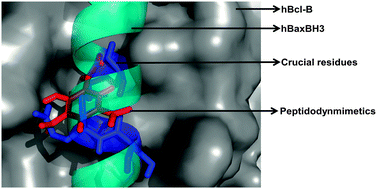Screening efficient BH3-mimetics to hBcl-B by means of peptidodynmimetic method
Abstract
The crucial residues of hBaxBH3

* Corresponding authors
a
Structural Biology Lab, Department of Bioinformatics, School of Chemical and Biotechnology, SASTRA University, Thanjavur-613 401, TN, India
E-mail:
sivaram@scbt.sastra.edu
Fax: +91 4362 264120
Tel: +91 4362 264101 Ext.319
The crucial residues of hBaxBH3

 Please wait while we load your content...
Something went wrong. Try again?
Please wait while we load your content...
Something went wrong. Try again?
D. Sivakumar, B. Gorai and T. Sivaraman, Mol. BioSyst., 2013, 9, 700 DOI: 10.1039/C2MB25195G
To request permission to reproduce material from this article, please go to the Copyright Clearance Center request page.
If you are an author contributing to an RSC publication, you do not need to request permission provided correct acknowledgement is given.
If you are the author of this article, you do not need to request permission to reproduce figures and diagrams provided correct acknowledgement is given. If you want to reproduce the whole article in a third-party publication (excluding your thesis/dissertation for which permission is not required) please go to the Copyright Clearance Center request page.
Read more about how to correctly acknowledge RSC content.
 Fetching data from CrossRef.
Fetching data from CrossRef.
This may take some time to load.
Loading related content
